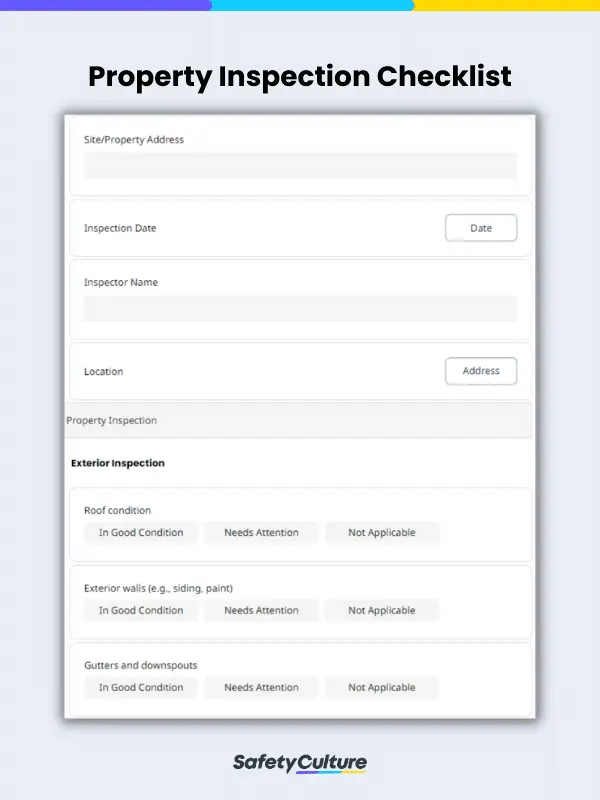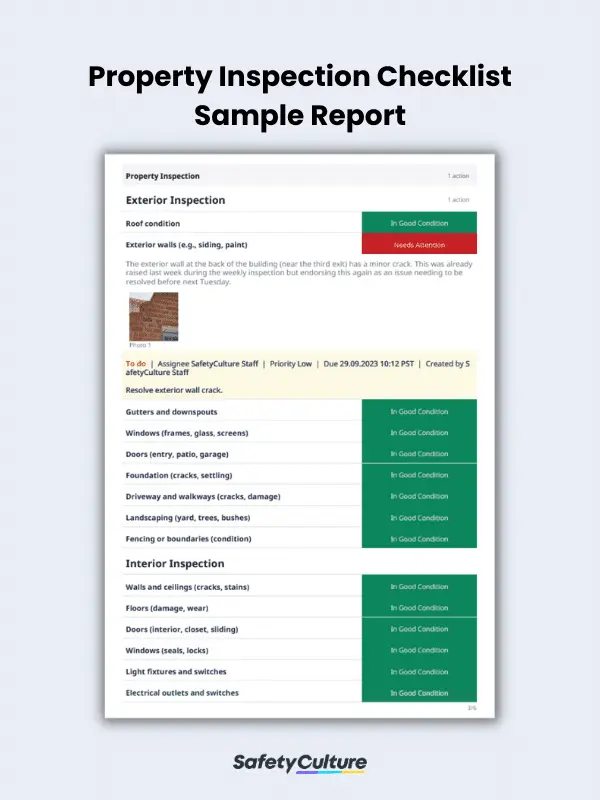What is a Property Inspection Checklist?
A property inspection checklist is a structured tool used to assess the condition of a property, such as a house, apartment, or commercial building, for various purposes including moving in, moving out, regular maintenance, or before buying or selling a property. This checklist serves as a comprehensive guide for homeowners, landlords, property managers, tenants, or real estate professionals to ensure that all relevant aspects of the property are inspected thoroughly.
Why Use a Property Inspection Checklist
Property inspection checklists are invaluable tools for anyone in charge of inspecting various types of properties. These tools provide a structured framework for assessing a property’s condition systematically.
Also, a property inspection checklist is useful for property managers to proactively catch and correct issues such as potential health and safety violations, property damage, and other maintenance problems before they result in costly liabilities.
Benefits of Using One
The consistent and proper use of property inspection checklists enables organizations and individuals in charge of these inspections to achieve the following advantages:
1. Comprehensive Assessment
Using a property inspection checklist guides you to examine every nook and cranny, from the roof to the foundation, helping to uncover hidden issues or potential problems early on. This comprehensive approach is vital for maintaining the property’s value and safety.
2. Efficient Organization
Property inspection checklists provide an organized framework for the inspection process. By outlining the areas and components to be inspected, they ensure a systematic approach. This not only saves time but also minimizes the risk of overlooking critical details, making the inspection process more efficient and effective.
3. Clear Documentation
A property inspection checklist also serves as a written record of the property’s condition, including any issues discovered during the inspection. This documentation is invaluable for future reference, legal purposes, negotiations, and dispute resolution. It promotes transparency and helps all parties involved in property transactions or rental agreements understand the property’s true condition, fostering trust and accountability.
What to Include in a Checklist for Property Inspections
Creating an effective checklist for property inspection tasks is crucial for ensuring a thorough assessment of a property’s condition. To help you cover all essential aspects and ensure that no critical issues or maintenance needs are overlooked, here’s an overview of what you must include in a property inspection checklist:
1. Property Details
Begin the checklist with basic property details, including the property’s address, date of inspection, and the names of the inspector(s) involved. This information provides context and helps track inspections over time.
2. Exterior Inspection
- Roof condition
- Exterior walls
- Gutters and downspouts
- Windows and doors
- Foundation
- Driveway and walkways
- Landscaping and yard
3. Interior Inspection
- Walls and ceilings
- Floors
- Doors and windows
- Light fixtures and switches
- Plumbing fixtures
- Kitchen appliances
- Cabinets and countertops
- Bathroom fixtures
- HVAC system
- Water heater
- Fireplace (if applicable)
- Attic and basement (if applicable)
4. Utilities
- Electrical system
- Gas lines (if applicable)
- Water supply and plumbing
- Sewer or septic system (if applicable)
5. Safety Features
- Smoke detectors
- Carbon monoxide alarms
- Fire extinguishers
- Emergency exits
- Stairs and railings
6. Additional Items (if applicable)
- Garage and its components
- Patio or deck
- Swimming pool or spa (if applicable)
7. Notes and Comments
Include space for the inspector(s) to jot down notes, comments, or observations. This is where you can document any issues, repairs needed, or recommendations for maintenance.
How to Create and Use a Property Inspection Checklist
Here’s a step-by-step guide on how to create and effectively use a property inspection template:
Creating the Checklist
- List the key areas and components of the property that need to be inspected. This typically includes the exterior, interior, utilities, safety features, and any unique aspects.
- Under each key area, itemize specific inspection points. For example, under “Exterior,” include items like “Roof condition,” “Siding condition,” and “Gutter functionality.”
- Include space for notes and comments, or ask for media files next to each inspection point to allow inspectors to document their observations and any issues discovered.
Using the Checklist
- Start at one end of the property and work systematically through each item on the checklist to ensure nothing’s overlooked.
- Alongside written notes, consider taking photos or videos to visually document the property’s condition for an extra layer of evidence.
- If any issues are discovered during the inspection, note them on the checklist. This information is crucial for addressing repairs or maintenance later.
- In property transactions or rental agreements, share the checklist with relevant parties (e.g., buyers, sellers, tenants, landlords) to maintain transparency and ensure everyone is aware of the property’s condition.
- Property inspections should not be limited to move-in or move-out situations. Conducting regular inspections using checklists can help identify and address issues before they become major problems.
Review and Maintenance
- Regularly review and update your property inspection checklist to account for changing needs, property features, or local regulations.
- Store and organize completed checklists and inspection reports, which can be used for legal purposes or future property assessments.
- Based on the checklist findings, take the necessary actions to address repairs, maintenance, or safety concerns promptly.
To give an example, here’s what a filled-out property inspection checklist looks like:
FAQs About Property Inspection Checklists
The requirement for property inspection checklists can vary by location and specific circumstances. Some rental regulations may mandate inspections and documentation, while others may not have such requirements. Hence, it’s essential to check applicable local laws and regulations.
Yes, tenants or buyers can use these checklists on their own to assess a property’s condition before committing to a lease or purchase. It’s a proactive way to identify issues or negotiate repairs. However, final inspection reports must still be created and documented by authorized professionals before any transactions.
Yes, property inspection checklists can be used for new constructions or renovations to ensure that the work has been completed to the client’s or property manager’s satisfaction. Also, such checklists can be used to verify that there are no defects or issues that need to be resolved.



